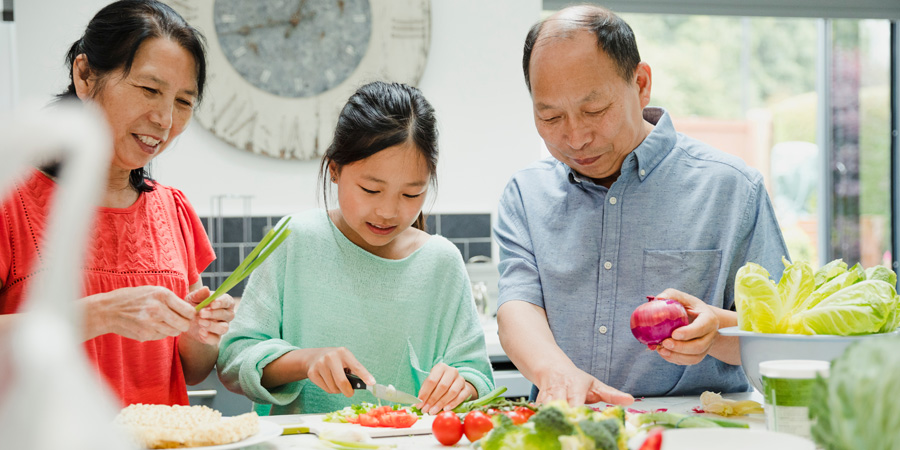Rural China: Fruit and vegetable consumption is associated with a reduced risk of type 2 diabetes

In 2018, the number of Chinese adults suffering from diabetes was estimated to be 129.8 million (approximatively 12,8% of Chinese adults in 2017), ranking China as the first country in the world with the highest number of diabetic patients (Li, 2020; Cho, 2018). To prevent diabetes, especially diabetes type 2, a healthy diet rich in fruit and vegetables is essential. In the last 30 years, the Chinese diet has been modified with the urbanization (Schwingshackl, 2017). The intake of meat, dairy products, refined grains, and unhealthy processed foods has progressively grown and consumption of vegetables, fruit, soybeans, and nuts has gradually improved from the initial deficiency to a primary balance (Han, 2020; Chang, 2018).
Previous studies explored the link between fruit and vegetable and type 2 diabetes with conflicting results(Halvorsen, 2021; Zheng, 2020; Li, 2014). Yet, few were conducted on Chinese communities, and even less on Chinese rural populations, a group who most commonly consume fruit and vegetables.
Therefore, this study explores the dose-response relationship of fruit and vegetable consumption and type 2 diabetes risk in rural China (Niu, 2022).
Clinical and biological measurements differ between individuals with and without type 2 diabetes.
The results show that individuals with type 2 diabetes were older, with higher waist and hip circumference, BMI, insulin, glucose, total cholesterol, triglycerides, and LDL-C than participants without type 2 diabetes. Patients suffering from type 2 diabetes seemed also to be more likely to have hypertension, dyslipidemia, and a family history of diabetes, but less likely to be current smokers and drinkers. In the meantime, lower HDL-C, total energy intake, total carbohydrate intake, income, education level, and physical activity intensity were observed among individuals with type 2 diabetes.
High intake of fruit and combined F&V is related to a reduced risk of type 2 diabetes in rural Chinese populations.
A correlation was observed between a higher fruit intake and a decreased risk of type 2 diabetes in this study, with a 59.1% lower risk of type 2 diabetes across extreme quintiles. In addition, the dose-response analysis demonstrates that participants in rural China who consume daily more than 260 g of fruit had a lower risk of developing type 2 diabetes, while those with less fruit intake were at increased risk. These results are in line with the findings of numerous studies reporting a correlation between higher fruit intake and a reduced type 2 diabetes risk (Halvorsen, 2021; Li, 2014; Bazzano, 2008).
Another correlation was also observed between combined fruit and vegetables and type 2 diabetes risk. Thus, in this study, higher intake of fruit and vegetables was linked to a 34.2% lower risk of type 2 diabetes. After analyzing the dose-response relationship, the odds of type 2 diabetes decreased significantly with fruit and vegetable intake between 600 and 1000 g/day in individuals living in rural China. However, no significant association was observed with an intake above 1000g/day. This association between combined fruit and vegetables intake and type 2 diabetes risk was also highlighted in other studies (Halvorsen, 2021; Zheng, 2020; Cooper, 2012).
Unlike other research conducted in Western countries (Villegas, 2008; Cooper, 2012), this work did not demonstrate a significant association between vegetable consumption and type 2 diabetes, which may be explained by the cultural diversity and the disparities in dietary patterns.
Vitamins, fibers and bioactive substances from fruit and vegetables play a role to prevent type 2 diabetes.
The inverse association observed between fruit intake and the risk of type 2 diabetes can be explained by the low glycemic index of fruits most commonly consumed in rural China (apples, grapes, bananas) (Jenkins, 2011).
As regards the effect of combined fruit and vegetables intake, it may be explained the wide range of nutrients and compounds found in fruit and vegetables that are beneficial in type 2 diabetes prevention:
- Antioxidants such as certain vitamins (A, C) and carotenoids play a major role in the elimination of free radicals produced during metabolism, helping to relieve oxidative stress on islet β cell damage, and therefore preserve blood sugar stability and reduce the risk of type 2 diabetes (Bahadoran, 2013)
- fibers are involved in reducing insulin resistance, improving insulin sensitivity and modifying the intestinal microbiome, thereby reducing the risk of type 2 diabetes (Gurung, 2020).
- anti-inflammatory bioactive substances and minerals such as magnesium, reduce insulin resistance, and can therefore reduce the risk of developing type 2 diabetes (Krishnaswamy, 2018)
However, the specific biological mechanisms are relatively complex and will require further research in the future.
Based on: Niu K, et al. The dose-response relationship of fruit and vegetable intake and risk of type 2 diabetes among rural China: The Henan Rural Cohort study. Prim Care Diabetes. 2023 Apr;17(2):161-167.
- High intake of fruit alone or combined fruit and vegetables is related to a reduced risk of T2D in rural China.
- Fruit intake ≥ 260 g/day and total fruit and vegetables consumption of 600–1000 g/day should be encouraged to promote good health, specially type 2 diabetes.
